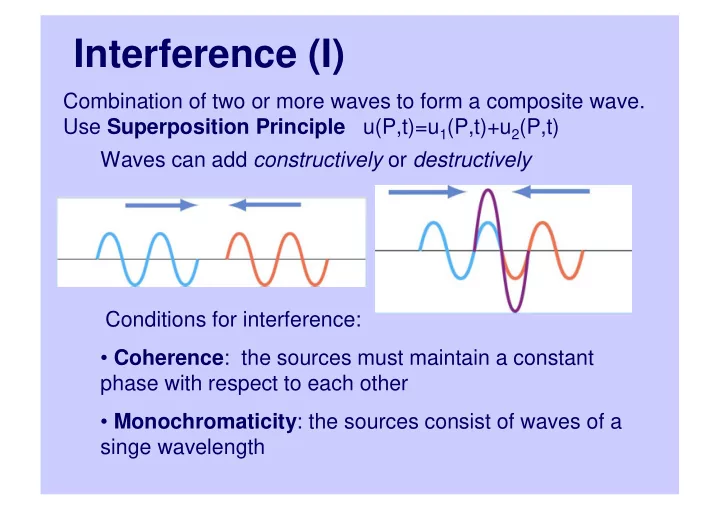

Interference (I) Combination of two or more waves to form a composite wave. Use Superposition Principle u(P,t)=u 1 (P,t)+u 2 (P,t) Waves can add constructively or destructively Conditions for interference: • Coherence : the sources must maintain a constant phase with respect to each other • Monochromaticity : the sources consist of waves of a singe wavelength
Interference. Phase shift. What can introduce a phase shift? • Waves from different, out of phase sources • Sources in phase, but travel different distances • Double slit, • Diffraction •Thin films • Waves traveling in opposite direction
Standing waves (I) λ n =2L/n; f n =c/ λ n =n f 0 ; with f 0 =c/(2L) f n =n f 0 Fundamental f 0 , n-th harmonic
Standing waves(II)
Wave groups (I) • A harmonic wave does not carry information (only a number f or λ ) • Two harmonic waves carry two numbers and so on
Wave groups (II) • For larger information we need an enormous amount of harmonic waves in a small interval in wave number, wavelength or frequency: [ k 0 - ∆ k/2, k 0 - ∆ k/2 ] or [ f 0 - ∆ f/2, f 0 - ∆ f/2 ] + ∆ k k / 2 0 = − ω + ϕ u ( x , t ) a ( k ) cos( kx ( k ) t ( k )) d k ∫ 0 − ∆ k k / 2 0 = − − ω ⇒ u ( x , t ) A ( x v t ) cos( k x t ) 0 0 g • A(x-v g t) carries all the information
Wave groups (III) Wave modulated in amplitude A(x-v g t) Modulating wave • Phase velocity v= v(k) • Dispersion ω = ω ( k ) • Group velocity v g ≠ v 0 • Band width ∆ f << f 0 cos( k 0 x - ω 0 t ) carrier signal d ω = v g d k k 0
Recommend
More recommend